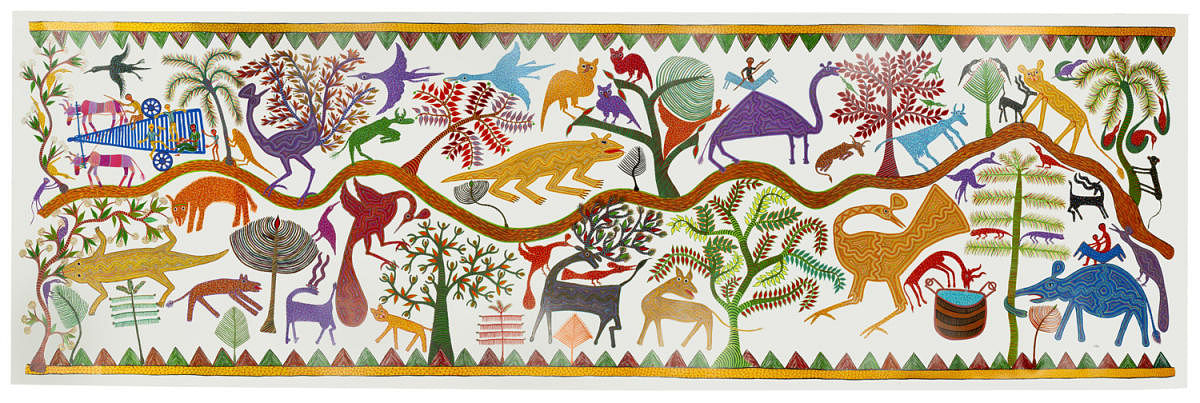
Bhuri Bai is amongst those artists who have proved that success unfolds only by staying rooted. She has not only taken Bhil art to the world audience, but has also ensured it doesn't fade from public memory.
In a candid conversation, she reveals how art means everything to her. Padmashri Bhuri Bai fondly remembers how as a child she watched for hours the village badwas or priests create the sacred Pithora paintings on the cow dung and chalk-laced walls of rustic Bhil mud huts — a popular custom in the Pithol village of Jhabua district in Madhya Pradesh — her hometown. When one makes a wish, they promise Pithora dev to paint the walls of the house once it is fulfilled. The natural colours of geru (ochre soil) and white chalk on the sun-dried mud walls make a distinct colour contrast. The elegance lies in its simplicity.
This traditional art was the domain of men, especially drawing the image of the reigning deity of the village, Pithora Dev. A young Bhuri Bai found refuge from the biting poverty of her family in her art. She bent the rules and started decorating the walls of her hut with images that she observed in her everyday life. Having immense pride and respect for the Bhil culture she was born into, she restricted herself from drawing any religious iconography like the horses dedicated to the god. Long before she became the first Bhil woman to wield a paintbrush to immortalise Bhil life and customs, she was called upon in her village to paint the walls to mark important festivals and celebrations like weddings and birth ceremonies.
Her most outstanding work includes the extensive and vibrant murals on the 70-feet high wall, narrating the story of her own life at the Madhya Pradesh State Tribal Museum where she now works as a resident artist. She has not only created Pithora paintings on paper, canvas, mud pots, wood and textile, but has also illustrated several children’s books.
Many experimentations
The Museum of Art & Photography (MAP), through an online exhibition, recently collated an entire range of her work beginning with earlier untitled paintings, recent works done on a large scale, photographs from her private collection and audio interviews to narrate her story in her own voice. The curators, Nathaneil Gaskell, Mustafa Khanbhai and Shrey Maurya, encouraged Bhuri Bai to narrate her empowering journey in her voice, albeit in a structured manner.
Previously, Bhuri Bai sourced natural colours to create the unique Bhil folk art. At the age of 17, when she was a construction worker at Bharat Bhavan, a government arts institute in Bhopal, she had a chance encounter with artist and writer Jagdish Swaminathan. He noticed her innate talent and supplied her with poster paints, brushes and brown packing paper: materials she had never seen or used before. One can imagine her quandary. She mentions, "Initially, I was confused how to use the brush and colours correctly. I wondered how to make the colours light and dark and the right way to use the brush. There is a lot of difference between painting on the wall and on paper and it was a bit difficult in the beginning. He guided me and with practice, I gained confidence over the medium. He really loved my paintings.”
Traditionally, Pithora art was done only on walls with one or two colours. She experimented with different shades and themes keeping the visual grammar of her traditional Bhil art and techniques intact. The genuineness of an observant artist found true expression when she captured whatever she experienced in her paintings. These were often idyllic scenes from her village life that expressed her love for nature, especially the local flora and fauna, and later she shifted to more contemporary subjects when she arrived in the city. For instance, motifs such as beautiful peacocks that are considered auspicious, elephants that come to the village during Diwali, the ox cart, which is the only mode of transport in the village, find their way into her painting. She has also drawn airplanes in which she toured different countries. What makes her stand out is her ability to reinterpret traditional Bhil imagery for the modern global audience.
Speaking of different mediums, she observes, “The paintings made on the mud walls were frequently erased and new designs were made. However, while painting on paper, I ensured it was neat and of permanent value. The shelf life of these paintings is long. I wanted to make something that people would love to preserve for years to come. Many of these themes are now made keeping in mind the popular demand.” Otherwise, Bhuri Bai conjures these images from her imagination and does not fall back on any references or inspiration.
She has taught this art to all her family members and the girls in her village in a bid to keep it alive. She loves teaching this art form. She encourages the next generation in her words, "Pithora art is our tradition and we ought to keep it alive by practicing it. Never forget your roots.”